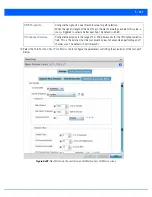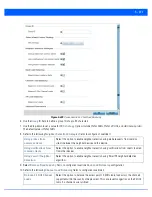
5 - 381
38. Select
OK
to save the updates and overrides to the MINT Protocol Rate Limits configuration. Select
Reset
to revert to the
last saved configuration.
39. Select the
Miscellaneous
menu item.
VLAN
When the Protocol is set to
link
and the Link Type is set to
VLAN,
use the spinner
control to select a virtual LAN from 1 - 4094 to refine the rate limiting configuration to
a specific VLAN.
IP
When the Protocol is set to
link
and the Link Type is set to
VLAN
, enter the IP address
as the network target for rate limiting.
Port
When the Protocol is set to
link
and the Link Type is set to
VLAN
, use the spinner
control to set the virtual port (1 - 65,535) used for rate limiting traffic.
Rate
Define a rate limit between 50 - 1,000,000 kbps. This limit constitutes a threshold for
the maximum the number of packets transmitted or received (from all access
categories). Traffic that exceeds the defined rate is dropped and a log message is
generated. The default setting is 5000 kbps.
Max Burst Size
Use the spinner to set the maximum burst size from 0 - 1024 kb. The smaller the burst,
the less likely the upstream packet transmission will result in congestion for the
WLAN’s client destinations. By trending the typical number of ARP, broadcast,
multicast and unknown unicast packets over a period of time, the average rate for
each access category can be obtained. Once a baseline is obtained, administrators
should add a 10% margin (minimally) to allow for traffic bursts. The default burst size
is 320 kbytes.
Background
Configures the random early detection threshold (as a percentage) for low priority
background traffic. Background packets are dropped and a log message generated if
the rate exceeds the set value. Background traffic consumes the least bandwidth of
any access category, so this value can be set to a lower value once a general upstream
rate is known by the network administrator (using a time trend analysis). The default
setting is 50%.
Best-Effort
Configures the random early detection threshold (as a percentage) for low priority best
effort traffic. Best-effort packets are dropped and a log message generated if the rate
exceeds the set value. Best effort traffic consumes little bandwidth, so this value can
be set to a lower value once a general upstream rate is known by the network
administrator (using a time trend analysis).The default setting is 50%.
Video
Configures the random early detection threshold (as a percentage) for high priority
video traffic. Video packets are dropped and a log message generated if the rate
exceeds the set value. Video traffic consumes significant bandwidth, so this value can
be set to a higher value once a general upstream rate is known by the network
administrator (using a time trend analysis).The default setting is 25%
Voice
Configures the random early detection threshold (as a percentage) for high priority
voice traffic. Voice packets are dropped and a log message generated if the rate
exceeds the set value. Voice applications consume significant bandwidth, so this
value can be set to a higher value once a general upstream rate is known by the
network administrator (using a time trend analysis).The default setting is 0%.
Summary of Contents for WiNG 5.7.1
Page 1: ...WiNG 5 7 1 ACCESS POINT SYSTEM REFERENCE GUIDE ...
Page 2: ......
Page 3: ...WING 5 7 1 ACCESS POINT SYSTEM REFERENCE GUIDE MN001977A01 Revision A April 2015 ...
Page 4: ...ii WiNG 5 7 1 Access Point System Reference Guide ...
Page 24: ...1 4 WiNG 5 7 1 Access Point System Reference Guide ...
Page 36: ...2 12 WiNG 5 7 1 Access Point System Reference Guide ...
Page 72: ...3 36 WiNG 5 7 1 Access Point System Reference Guide ...
Page 470: ...5 386 WiNG 5 7 1 Access Point System Reference Guide ...
Page 472: ...6 2 WiNG 5 7 1 Access Point System Reference Guide Figure 6 1 Configuration Wireless menu ...
Page 624: ...7 46 WiNG 5 7 1 Access Point System Reference Guide ...
Page 724: ...9 56 WiNG 5 7 1 Access Point System Reference Guide ...
Page 783: ...12 35 Figure 12 46 Device Summary screen 4 Click File Management ...
Page 816: ...12 68 WiNG 5 7 1 Access Point System Reference Guide ...
Page 1006: ...13 190 WiNG 5 7 1 Access Point System Reference Guide ...
Page 1026: ...14 20 WiNG 5 7 1 Access Point System Reference Guide ...
Page 1028: ...A 2 WiNG 5 7 1 Access Point System Reference Guide ...
Page 1089: ......
Page 1090: ...MN001977A01 Revision A April 2015 ...
















































